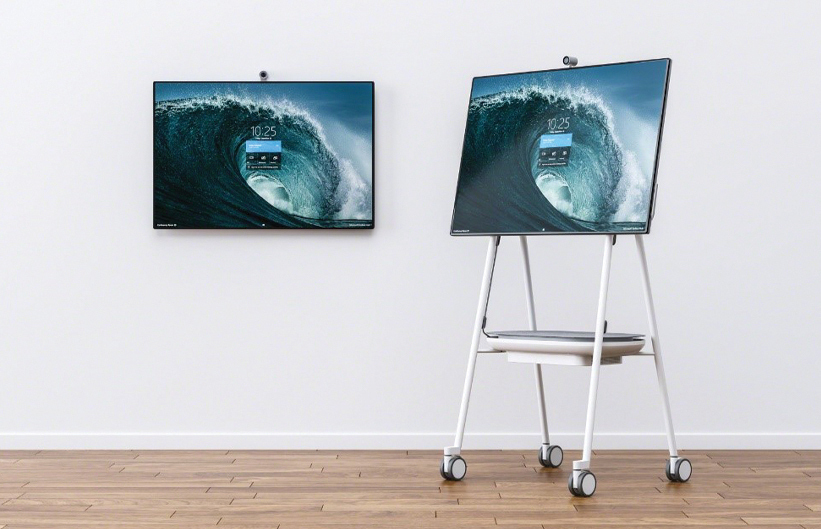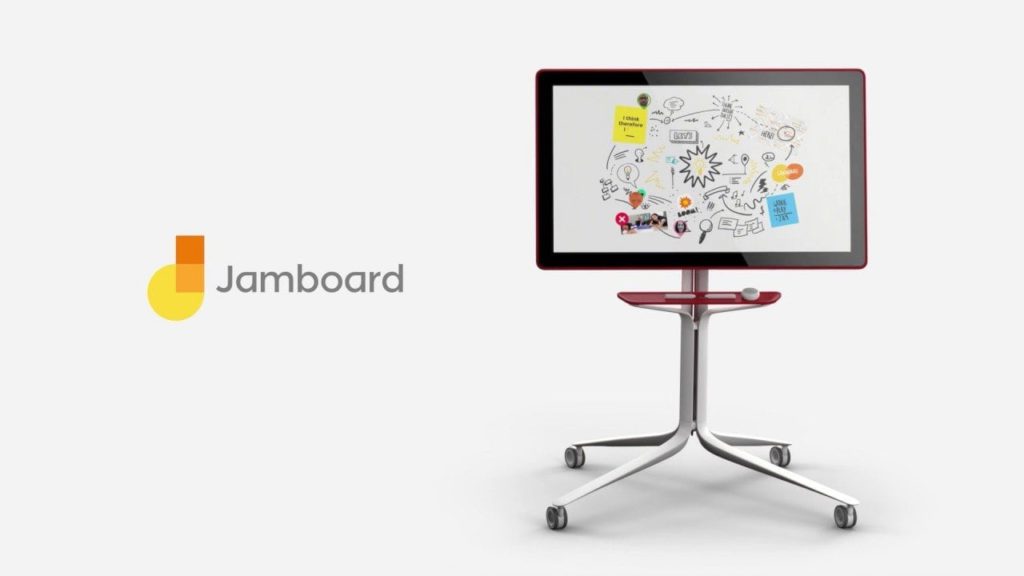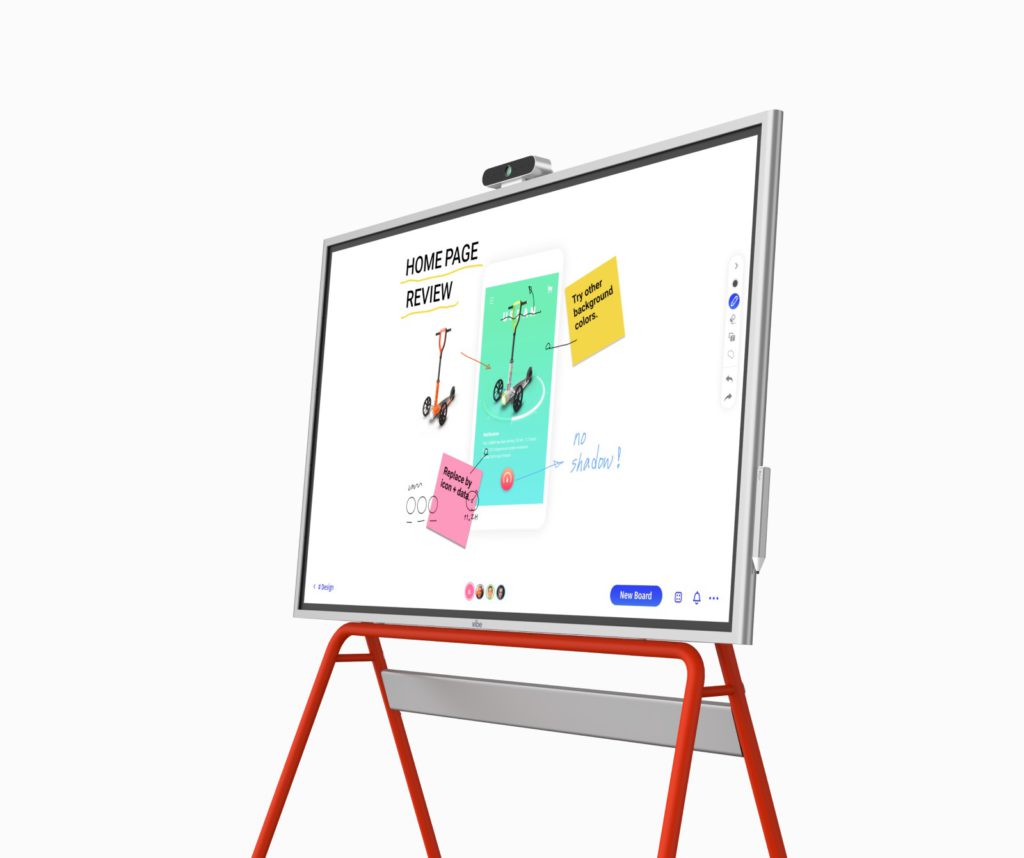There are several smart whiteboards available on the market, but which one is the best? What sets each digital whiteboard apart? Most importantly, which one best fits your needs?
Our smart whiteboard review has got you covered with all the details!
Related: Digital Whiteboards: The 11 Best Reasons to Invest
Microsoft Surface Hub 2S (50″)
 Surface Hub 2S
Surface Hub 2S- Advantages
Microsoft was one of the pioneers of the digital whiteboard, and their Surface Hub has been a popular option in this space over the years. The Surface Hub 2S features a responsive touchscreen display and robust integrations with Microsoft applications. With customized, collaboration-based Windows software and video conferencing capabilities, the Surface Hub 2S makes hosting meetings easy.
- Drawbacks
That being said, the Surface Hub 2S does have some significant drawbacks— mainly its heavy reliance on the Universal Windows 10 application ecosystem. This can be problematic for offices that don't primarily use Microsoft software, causing a whole myriad of connectivity issues. For example, connecting via Skype requires an Exchange Server or an Office 365 for the Business account, along with Skype for Business. This means that calling non-Skype users — e.g., most of your freelancers and remote employees — isn’t easy.
- Price
The Surface Hub costs over $5,000 more than its closest competitor, coming in at just under $9,000 per unit. If you're looking for extra features, such as the Surface Hub 2 Smart Camera or a larger screen, the board can cost up to $21,999.99.
You can learn more about Vibe as a Microsoft Surface Hub alternative on our comparison page.
Google Jamboard
 Jamboard
Jamboard- Advantages
Launched as a direct competitor to the Surface Hub, Google's Jamboard has been successful in mimicking much of the Surface Hub's functionality, but with some downsides.
On the plus side, the Jamboard features a vibrant 4K display with touchscreen capabilities for easy whiteboarding. Using Android and iOS apps, users can access whiteboard content on a range of personal devices. Thanks to its intuitive design, Jamboard has also become popular with educators.
- Drawbacks
Similar to the Surface Hub, the Jamboard is rescricted by its app ecosystem. The Jamboard offers a limited suite of integrations, which for many offices means having to adjust workflows to work with it. Additionally, some reviewers have reported glitches in the software.
- Price
The Jamboard costs just under $5,000 per board, with a one-time management and support fee payment of $600— still a whopping $2,000 more than its alternative. Read more about how Vibe stacks up against Google Jamboard on our comparison page.
Samsung Flip 2 (55″)
 Samsung Flip 2
Samsung Flip 2- Advantages
The budget answer to the more powerful Jamboard and Surface Hub, the Samsung Flip 2 is a bare-bones smart whiteboard for small- to mid-sized businesses. It comes with an attractive price tag and features real-time whiteboard capabilities on its UHD 4K touch display. The Flip 2 works wirelessly with Samsung mobile devices (as well as other manufacturer’s products using an app, though with more limited functionality).
The Flip’s most stand-out feature— and the one that gives it its name— is that its 55-inch screen can pivot on its stand (sold separately), going from horizontal to vertical in an instant.
- Drawbacks
The Flip 2 doesn’t come with a full-featured operating system. While you can share whiteboarding sessions with remote users, there’s no webcam, so you can’t connect with them face-to-face.
- Price
The Samsung Flip 2 costs just under $2,199 per board.
Read more about Vibe vs. Samsung Flip 2 on our comparison page.
 The team at Fluxspace brainstorming on a Vibe interactive whiteboard.
The team at Fluxspace brainstorming on a Vibe interactive whiteboard.Vibe Smart Whiteboard
A relative newcomer to the space, the Vibe Board was designed from scratch by an independent technology company to fill a gap left behind by Samsung, Microsoft, and Google. It has similar capabilities to its competitors, with manufacturer-agnostic app integrations and a more competitive price tag to boot.
Vibe takes full advantage of the cloud, so users can brainstorm with both in-person and remote users on an infinite canvas, all in real-time. With every session saved automatically in the cloud, you never have to worry about losing your work. In fact, you can join a Vibe Canvas from any device you'd like, so you can work when and where you want.
With a robust suite of built-in integrations that includes Google Drive, Dropbox, OneDrive, Slack, Microsoft Teams, Zoom, WebEx, Asana, and more, users will find that Vibe slots in nicely with existing workflows.
Vibe is also a powerful multitasker that seamlessly shifts between apps. Whether you're using Vibe's AI Smart Camera or one of the many compatible USB webcams, Vibe allows teams to video conference with 3rd party apps and share the whiteboard screen with split-screen mode. Vibe also supports screencasting from computer and mobile devices to the board, regardless of the device manufacturer. This is a game-changer for remote teams!
 Vibe 55" smart board
Vibe 55" smart boardOne of the biggest selling points? The price. At $3,299.00, Vibe packs in all your favorite features and capabilities into one sleek device—all for a fraction of the cost of a Google Jamboard or Surface Hub.
Related: What's an Interactive Whiteboard, and What Does It Do?
Why you should consider Vibe
Different smart whiteboards are designed to suit different business needs. Finding the right smart whiteboard comes down to balancing the features and capabilities you need with the budget you can afford.
That being said, Vibe's modest price tag, limitless canvas, and simple workflow integrations are likely to suit most users, especially small- to mid-sized marketing and design agencies, startups, and tech firms.
With Vibe, sharing ideas with collaborators — in-house, across town, or around the globe — has never been easier. Vibe is the perfect addition to any collaborative workspace. For companies that thrive thanks to a network of remote collaborators, it’s a must-have device.
Another less obvious (but extremely valuable) advantage Vibe has over its competitors is its small production and development team. Vibe offers white-glove customer support, and their team consistently makes changes to VibeOS based on user requests.
"Overall, we’ve been very impressed by Vibe and the team behind it," says Vibe user Peter Parker, Director of Advanced Analytics at Attunix. "They’ve been super receptive to our feedback and have incorporated suggestions and requests, both big and small, into the product. We’re often finding new ways of integrating Vibe into our everyday work to make us all more productive and efficient."
Ready to work the way you want? Request a Vibe demo, visit the knowledge center, or check out our blog.
Microsoft Surface Hub 2S info retrieved 3/20/23 from source | source | source | source
Google Jamboard info retrieved 3/20/23 from source | source
Samsung Flip 2 info retrieved 3/20/23 from source | source
[Editor's note: this post was originally published April 29, 2019 and was updated March 20, 2023.]
Looking for the latest in interactive whiteboard technology? Check out Vibe today!







-1sbltxxq4FYxHrXrwJVLsCDNsXpqNa.webp)
-5Zp0pmSytvcuYDVs1LvuwplKuRneK0.webp)
